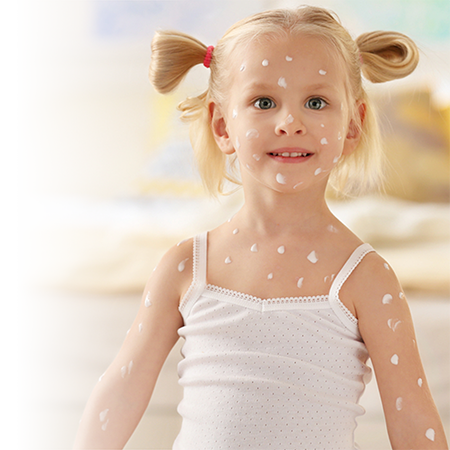Varicella is undoubtedly the most well-known childhood disease. Because it raises a lot of questions for parents, here is some information on the subject.
What is varicella?
Varicella, formerly called "chickenpox", is an infection caused by the varicella-zoster virus. It is a very contagious illness that mainly affects children, but that can also occur in adults. Before the existence of the varicella vaccine, 90% of children contracted the disease before the age of 15.
Varicella is transmitted by air-born droplets carried in the cough, sneeze or exhalation of an infected person. It can also be transmitted by contact with the fluid-filled lesions on the skin. After being infected by the varicella virus, we become immunized against the disease. However, once the episode of varicella has ended, the virus remains latent in the sensory nerve ganglia and can be reactivated later in life, but this time in another form: shingles.
The signs and symptoms of varicella appear 10 to 21 days (14 to 16 days on average) after the person was infected. Contagiousness starts about 2 days before the onset of the skin rash up until the skin lesions crust over.
What are the signs and symptoms of varicella?
The first symptoms of varicella resemble those of several other viral infections:
- fever
- general feeling of malaise
- fatigue
- loss of appetite
- abdominal pain
- sore throat
- headaches, and
- muscle soreness
These symptoms often appear one or two days before the onset of the skin rash typical of varicella. They sometimes occur simultaneously.
The skin rash begins with small red pimples and spots that transform into liquid-filled vesicles. The vesicles eventually dry out and crust over. The rash first appears on the head, face, back or stomach. It then spread to the entire body, including the scalp, inside the mouth, and to the genitals. Intense itching, which causes children to scratch, accompanies the skin rash. The skin rash disappears after a week, on average.
How can varicella symptoms be relieved?
There is no treatment for varicella, since it is a viral infection. However, several measures can help to relieve the symptoms. Here are some examples:
- Drink plenty of liquids.
- Rest.
- Use acetaminophen to relieve the fever. It is important to avoid aspirin (acetylsalicylic acid) or any product that contains it.
- Use cold compresses or add colloidal oatmeal to bath water to ease itching.
- Have you child wear light weight, soft clothing. Avoid coarse fabrics.
- Keep your child's nails short and clean and have him/her wear gloves at night to prevent scratching.
Certain creams and lotions available at the pharmacy can also be useful. The use of oral medication is rarely necessary. Your pharmacist can help you in your product choices.
How can varicella be prevented?
Fortunately, there is an effective way to prevent varicella: immunization. The vaccine against varicella is available in Quebec since 1998, and is provided free of charge for all babies as part of the universal immunization program since 2006. Immunization is recommended in all children 12 months and older who do not present any contraindications to the vaccine. It can also be suitable for non-immunized adolescents and adults. Some formulations of vaccines provide protection against several diseases, including varicella.
Varicella is a very contagious disease and is difficult to prevent without immunization. The infectious period begins before the appearance of the skin rash, which complicates things. If you are not immunized against varicella, avoid all contact with an individual infected by the disease. This is particularly important for individuals at risk of complications (e.g. immuno-compromised persons) and pregnant women.
Today, varicella is an early childhood disease that can easily be prevented owing to immunization. However, if you are ever faced with this disease, you are now able to recognize it and deal with it..
Speak to your pharmacist for additional information about varicella or vaccines.

